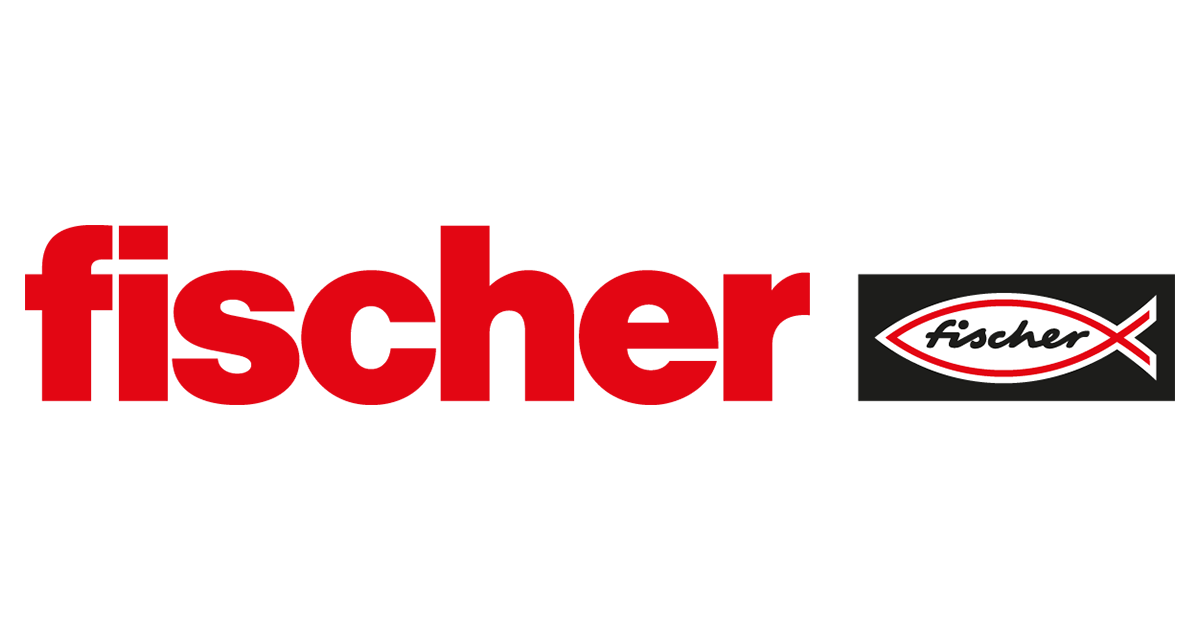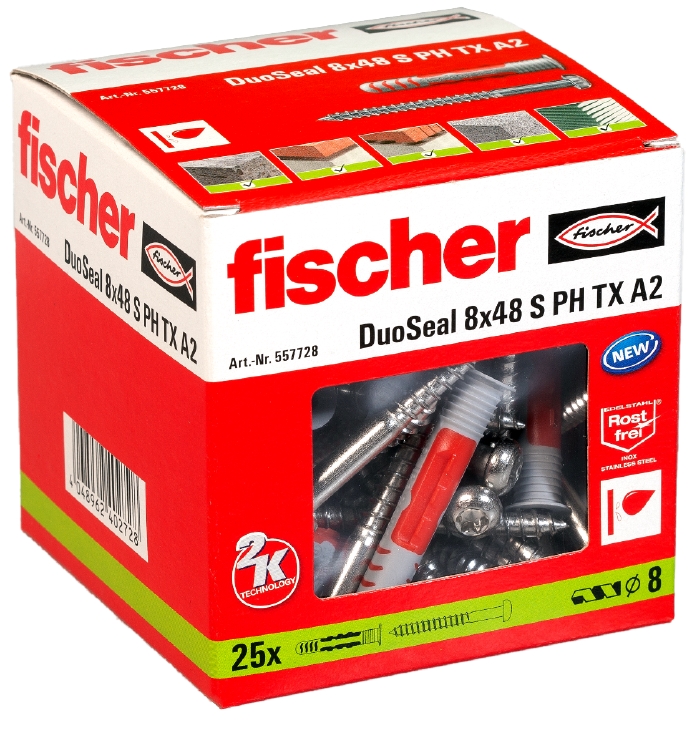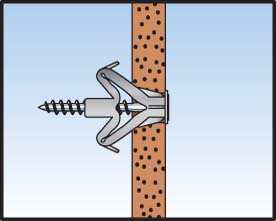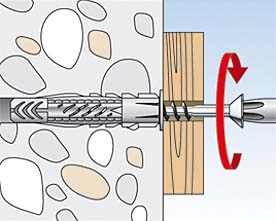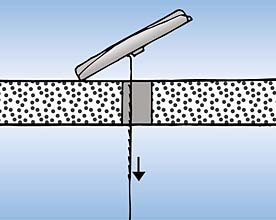Dowels
Dowels are a useful tool for anchoring fasteners such as screws and bolts in materials. In our range you will find a wide variety of different types of dowels for different types of installation, different dowel materials and for every area of application. Browse through the large selection now and find the right anchor for your specific application!

- Comprehensive advice & support
- over 10,000 articles in the shop
- Shipping in 24 hours
- thousands of satisfied customers

KATHRIN BRANDT
Employee Purchasing from TroisdorfGreat advice and friendly service. I was helped immediately and competently with any questions. Gladly again.

OMAR NASER
Office Manager from Frankfurt a.M.Goods are well packaged and arrive safely, which is important to me. My mail was answered immediately.

RAINER SEIDEL
Master carpenter from WiesbadenHad to replace a lamp, but the same was no longer available. Great advice, found a suitable replacement and delivered it quickly.
What is an anchor?
An anchor is a type of fastening element for screws, bolts, anchor rods or other connecting elements. An anchor can be used to anchor these in the material if they themselves do not have sufficient inherent strength. Anchors are generally used for materials such as concrete, bricks, plasterboard walls, sand-lime brick, cavity constructions, gypsum fiber boards or hollow blocks. The positive fit that the anchor forms with the material means that the loads of the objects you are fastening can be distributed over a larger area. This ensures greater stability.
The different types of dowels
Dowels are available in many different designs for numerous areas of application. The choice of the right anchor depends on various factors. Among other things, you should determine the weight of the load so that you know what load-bearing capacity your anchor must have. It is also important to know the material, the type of load, the anchor material, the installation method, the area of application and the substrate material.
According to operating principle
Dowels can be constructed in different ways, and the operating principle can also vary. The best known is the so-called expansion plug. This expands in the drill hole when you screw in the screw. This allows the material to be clamped in place. Another option is the tilting plug. As soon as you turn the screw into the tilting plug, part of the plug tilts behind the wall and can thus create a stable hold. This type of plug can be used with lightweight or cavity materials in particular. The heavy-duty anchor expands in the drilled hole and anchors itself firmly in the substrate in order to be able to bear heavy loads. A chemical anchor uses a chemical reaction. This allows adhesive or mortar to harden in the drill hole and provide stability.
According to substrate material
You can and should also select your wall plug according to the substrate material. Not every anchor is compatible with every material. For example, heavy-duty dowels can be used for concrete. For solid brick or sand-lime brick, expansion plugs or heavy-duty plugs are a good choice. Tilt plugs or special cavity plugs are used for plasterboard or cavity walls, which are not as strong. However, panel dowels can also be used for plasterboard or panel building materials with cavities. For gas concrete or aerated concrete, there are special gas concrete plugs that offer good load distribution. For tiles and ceramics, only special anchors can be used, which enable particularly gentle anchoring. This is because these materials break and crack easily. For wood, there are both wooden dowels and expansion dowels that can be used for various projects, including in combination with chipboard screws for installation in chipboard.
By dowel material
It's not just the material of the substrate that you need to consider when choosing an anchor, but also the material of the anchor itself. This is decisive for the suitability in different areas of application as well as for the load-bearing capacity. The plastic plug, for example, is the most widely used. It is suitable for light fixings and substrate materials such as cavity and solid walls. These include plasterboard, brick and concrete. Metal anchors or steel anchors are suitable for medium and heavy loads. There are also chemical plugs, which usually consist of a two-component adhesive. This is applied to the pre-drilled hole and then hardens around an insertion rod or threaded rod. Chemical anchors have a high load-bearing capacity and can be used for almost any substrate, even in brittle or uneven materials. Other dowel materials include glass or ceramic, which are used for specific applications such as in electronics or precision mechanics.
According to mounting type
Choosing the right type of mounting makes installation easier and ensures that the anchoring is secure. With screw mounting, you simply turn the screw through the plug into the drill hole. The plug expands and can thus anchor itself in the material. Impact installation is carried out with an impact plug and hammer. This is because the plug is simply hammered into the material. With clamp installation, the clamping force between the clamping plug and the wall is used. You insert these plugs and they are clamped by screwing in a screw or pulling a pin. There is also press-fit installation with a press-fit plug, injection installation with chemical plugs, twist installation or nail installation with a nail plug.
By area of application:
If you want to use an anchor for indoor use, you need a different anchor than for outdoor use and vice versa. Anchors that you use indoors do not have to be weather-resistant. Plastic dowels are particularly popular here, as they are suitable for light to medium-heavy loads such as picture frames or shelves. In outdoor areas, it is also important to withstand weather influences such as UV radiation, rain and temperature fluctuations. This is why more durable materials are ideal for doweling. These include chemical dowels or metal dowels, for example.
Buy wall plugs at WATT24
In the WATT24 store you will find an extensive range of different plugs such as plasterboard plugs, nail plugs and universal plugs. Simply select the products you need and order them conveniently in our online store. Your order will be delivered to your doorstep in no time at all. Do you need other electrical installation and lighting technology products? Then you've also come to the right place.
At WATT24, we focus on excellent quality and reliable customer service so that you receive your desired product quickly. If you choose WATT24, you will benefit from numerous advantages, such as:
- Lightning-fast delivery - Your purchase will reach you in no time at all, without you having to wait long for it.
- Hassle-free and secure purchasing process - Your order is not only processed easily, but also with the highest level of security to guarantee your protection at all times.
- Diverse product range - Discover our extensive product range, which is specially tailored to your needs.
- Excellent quality from well-known brands - Enjoy our range of high-quality products that come exclusively from reputable suppliers.
Find the right wall plug now and buy it directly online at WATT24!
FAQ: Frequently asked questions about dowels
How is a dowel used?
Dowels are used in many DIY and construction projects. If you need to use dowels, the first step is to drill the hole at the point where the object is to be anchored later. Also note that the size and length of the drill hole depends on the type of dowel you choose. Once the hole has been drilled, you should thoroughly remove the drilling dust, for example with a vacuum cleaner or bellows. Only if the hole is clean can the plug be firmly secured later. You can then insert the plug into the drilled hole. This is usually easy to do with your finger. Make sure that the plug is flush with the wall. It can also easily sink into the wall. You can also use a hammer-in anchor for heavy objects. Insert this into the drill hole and then hammer it in with a setting tool. This allows the anchor to expand evenly and securely for firm anchoring in the wall. Once the anchor or dowel has been placed in the wall, you can attach your object to the wall.
What types of dowels are there?
There are many different types of dowel. The most common types of dowels are expansion dowels, tilt dowels, chemical dowels, plasterboard dowels, impact dowels, gas concrete dowels, standard dowels, nail dowels, universal dowels, cavity dowels, spring-loaded dowels, long-shaft dowels, plastic dowels and metal expansion dowels. But heavy-duty dowels, wooden dowels, panel dowels, frame dowels, aerated concrete dowels and insulation dowels are also popular.
What is a standard anchor and what is a special anchor?
Standard dowels are usually dowels that are also known as expansion dowels or universal dowels. They are used for various installation tasks as they are also suitable for a variety of substrates. These include solid bricks, hollow bricks, concrete and plasterboard. Special anchors, on the other hand, are intended for specific applications or materials. Plasterboard plugs, for example, are special plugs and are intended for plasterboard and plasterboard walls, which are particularly brittle and not so strong. But there are also specific dowels for gypsum fiberboard or other panel building materials, such as gypsum fiberboard dowels, panel dowels or direct fastening dowels.
What heavy-duty fixings are available?
Both chemical dowels and metal heavy-duty dowels are suitable for heavy-duty doweling. However, concrete screws, threaded anchors, steel anchors such as bolt anchors, roof anchors and façade anchors can also be used when it comes to fastening heavy loads and components.
How do insulation plugs work?
Insulation anchors or thermal anchors are used to attach insulation materials. This allows the insulation materials to be mounted on walls and ceilings to improve thermal insulation. To do this, a hole is drilled into the insulation board and the masonry. The drill hole depth must exceed the thickness of the insulation board and also meet the required anchoring depth in the masonry. The insulation plug can then be inserted into the pre-drilled hole. The length of the plug should extend through the insulation and deep enough into the masonry for stable anchoring.





